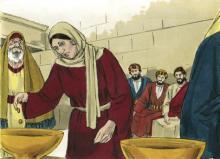The Pharisees ask whether it is lawful to pay tribute to Caesar.
Matthew 22:20 Whose is this image and superscription?
Matthew 22:20 Whose image is this? And whose inscription?
Of whom? The likeness, this one, and the inscription?
We cannot disregard labels just because they are often ignored.
Again, Jesus is clearly playing dumb for humorous effect. Jesus asks this question in the most off-hand way possible, playing dumb. The sentence doesn't even have a verb. This sense is lost in English translation where the verbs are added and, in the case of NLT, completely imagined. We must remember that Jesus's words were spoken, not written.
The two key nouns here, "image" and "superscription/inscription" only appear in this verse and the two parallels in Mark and Luke.
The word translated as "inscription" also means "title." The Tiberius silver denarius reads: "Ti[berivs] Caesar Divi Avg[vsti] F[ilivs] Avgvstvs" ("Caesar Augustus Tiberius, son of the Divine Augustus"). So the very title on the coin was blasphemous to the Judeans at the time.
- MW - Missing Word -- The word "the" before "image" is not shown in the English translation.
- MW - Missing Word -- The word "the" before "superscription" is not shown in the English translation.
- MW - Missing Word -- The word "the" before "image" is not shown in the English translation.
- IW - Inserted Word -- The word "whose" doesn't exist in the source.
- MW - Missing Word -- The word "the" before "superscription" is not shown in the English translation.
Whose -- The word translated as "whose" means primarily "anything" or "anyone." In a question, it can mean "who," "why," or "what." It is in the possessive form, so "of whom" or "whose." The form is genitive, so "of whom."
is -- There is no Greek word that is translated as "is" in the source we use today nor was there one in the source that the KJV translators used. It was added for clarity.
this -- "This" is translated from a Greek word that means "this," "that," "the nearer."
missing "the" -- (MW) The untranslated word is the Greek definite article. The Greek article is much closer to our demonstrative pronouns ("this," "that," "these," "those"). See this article for more.
image -- "Image" is from eikôn, which means "likeness," "image," "image in a mirror," "personal description," "semblance," "comparison," and "archetype." It is the source of our word "icon."
and -- The Greek word translated as "and" is used as the conjunction "and," but it also is used to add emphasis ("also").
missing "the" -- (MW) The untranslated word is the Greek definite article. The Greek article is much closer to our demonstrative pronouns ("this," "that," "these," "those"). See this article for more.
superscription? -- "Superscription" is from epigraphê, which means "inscription," "title," "ascription," and "description." It is from the verb that means, literally, "to write upon."
Whose image is this? And inscription?
Whose -- The word translated as "whose" means primarily "anything" or "anyone." In a question, it can mean "who," "why," or "what." It is in the possessive form, so "of whom" or "whose." The form is genitive, so "of whom."
missing "the" -- (MW) The untranslated word is the Greek definite article. The Greek article is much closer to our demonstrative pronouns ("this," "that," "these," "those"). See this article for more.
image -- "Image" is from eikôn, which means "likeness," "image," "image in a mirror," "personal description," "semblance," "comparison," and "archetype." It is the source of our word "icon."
is -- There is no Greek word that is translated as "is" in the source we use today nor was there one in the source that the KJV translators used. It was added for clarity.
this -- "This" is translated from a Greek word that means "this," "that," "the nearer."
And -- The Greek word translated as "and" is used as the conjunction "and," but it also is used to add emphasis ("also").
whose -- (IW) There is nothing that can be translated as "who" in the Greek source.
missing "the" -- (MW) The untranslated word is the Greek definite article. The Greek article is much closer to our demonstrative pronouns ("this," "that," "these," "those"). See this article for more.
superscription? -- "Superscription" is from epigraphê, which means "inscription," "title," "ascription," and "description." It is from the verb that means, literally, "to write upon."
Τίνος [252 verses](pron sg gen) "What" is from tis which can mean "someone," "any one," "everyone," "they [indefinite]," "many a one," "whoever," "anyone," "anything," "some sort," "some sort of," "each," "any," "the individual," "such," and so on. In a question, it can mean "who," "why," or "what."
ἡ (article sg fem nom) Untranslated is the Greek definite article, hos, ("the"), which usually precedes a noun and, without a noun, takes the meaning of "the one" or, in the plural, "the ones."
εἰκὼν [3 verses](noun sg fem nom) "Image" is eikôn, which means "likeness," "image," "image in a mirror," "personal description," "semblance," "comparison," and "archetype." It is the source of our word "icon."
αὕτη [137 verses](adj sg fem nom) "This" is houtos, which means "this," "that," "the nearer." As an adverb, it means "in this way," "therefore," "so much," "to such an extent," and "that is why."
καὶ [1089 verses](conj/adv) "And" is from kai, which is the conjunction joining phrases and clauses, "and," or "also." After words implying sameness, "as" (the same opinion as you). Used in series, joins positive with negative "Not only...but also." Also used to give emphasis, "even," "also," and "just."
ἡ (article sg fem nom) Untranslated is the Greek definite article, hos, ("the"), which usually precedes a noun and, without a noun, takes the meaning of "the one" or, in the plural, "the ones."
ἐπιγραφή; [3 verses](noun sg fem nom) "Superscription" is from epigraphê, which means "inscription," "title," "ascription," and "description." It is from the verb that means, literally, "to write upon."

